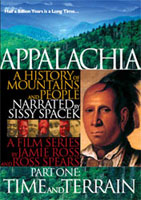
APPALACHIA: A History of Mountains and People
Introduced by the filmmakers Jamie Ross and Ross Spears
The Film
Appalachia: A history of Mountains and People will be the first film series ever to chronicle the riveting history of one of the world’s oldest mountain ranges and the diverse peoples who have inhabited them. The central character of this series will be the Appalachian Mountains themselves. The central theme will be how the mountains have shaped the people and how people have shaped the mountains — the dynamic interaction of natural history and human history.
Each section of the series will tell the story of Appalachia as the region passes under the control of a succession of different peoples, each with its unique ecology and corresponding philosophy about nature and our place in it.
Part I: Deep Time
 The series will begin and end with Earth‘s oldest mountains — the Appalachians. We see how continents over millions and millions of years collide in a slow dance which ultimately results in the formation of the mountains we now know as the Appalachians. We trace the evolution of the Great Forest which blankets the region in green, forming a home for a unique mosaic of plant and animal species.
The series will begin and end with Earth‘s oldest mountains — the Appalachians. We see how continents over millions and millions of years collide in a slow dance which ultimately results in the formation of the mountains we now know as the Appalachians. We trace the evolution of the Great Forest which blankets the region in green, forming a home for a unique mosaic of plant and animal species.
We watch as the first humans who arrived as early as 12,000 B.C. develop a complex and sophisticated relationship with the natural world. In Appalachia, we soon discover, geology is destiny. We see portraits of Appalachia’s Principal People at the time of European contact: the Cherokee, Shawnee, and Iroquois — vibrant, adaptive cultures with finely tuned relationships to their environment, a complex ecological community with amazing biological diversity. The arrival of the Europeans signals vast cultural and biological upheavals.
Part II: New Green World
 In Part II of APPALACHIA, two cultures, Native American and European, collide in a struggle for control of the mountains. In the conquest of new land, first come the surveyors and mapmakers, including young George Washington, then come the road and cabin builders. From ecologists, anthropologists, and geographers, we hear of the vast differences between the Native American and the European perceptions of the land and its resources, all of which comes to a head when gold is discovered in 1828 in the mountains of Georgia. Once again, geology is destiny.
In Part II of APPALACHIA, two cultures, Native American and European, collide in a struggle for control of the mountains. In the conquest of new land, first come the surveyors and mapmakers, including young George Washington, then come the road and cabin builders. From ecologists, anthropologists, and geographers, we hear of the vast differences between the Native American and the European perceptions of the land and its resources, all of which comes to a head when gold is discovered in 1828 in the mountains of Georgia. Once again, geology is destiny.
We see a new inhabitant, the pioneer, carving out a life on the Appalachia frontier, coming to terms with the wilderness, and creating a way of life unique to the mountains, one which will endure in different forms through the centuries, surviving even the cataclysm of the Civil War.
Part III: Mountain Revolutions
 “The race for the prize is on,” wrote Harper’s Magazine in 1872 as railroads pushed ever further into the mountains. Land buyers spread through every timber rich and mineral infused hollow, making deals. The third hour of the series will tell the story of the region as it confronts this strange new industrial age.
“The race for the prize is on,” wrote Harper’s Magazine in 1872 as railroads pushed ever further into the mountains. Land buyers spread through every timber rich and mineral infused hollow, making deals. The third hour of the series will tell the story of the region as it confronts this strange new industrial age.
The story begins in the Great Forest, where virgin timber still abounded as late as 1880. Coal camps replace villages; mountain farms are abandoned; missionary schools spring up; the land, the people, the wildlife and the culture are endangered. The first American school of scientific forestry is begun in North Carolina under the leadership of Gifford Pinchot, in the ruined forest of a millionaire‘s new estate — a tiny ray of hope.
Foresters, botanists, geologists, novelists, and historians all recount the changes in the land and its people as the coal is dug and the ancient trees are felled to fuel the nation‘s booming new industrial economy.
Part IV: Holding Up the Mountains
 The story of twentieth century Appalachia is the story of a rich but deeply troubled region forging its own distinct identity. From the union battles of the 1920s to the celebration of its rich cultural heritage in music, art and literature, to the enduring environmental and cultural dilemmas of our own time, Part IV will explore the heartbreak and hope of modern Appalachia.
The story of twentieth century Appalachia is the story of a rich but deeply troubled region forging its own distinct identity. From the union battles of the 1920s to the celebration of its rich cultural heritage in music, art and literature, to the enduring environmental and cultural dilemmas of our own time, Part IV will explore the heartbreak and hope of modern Appalachia.
Sociologists and ecologists point to Appalachia’s own inner eye, the ways in which trouble and pain, discovery and self-discovery fortify the region’s soul and backbone. We see new attitudes and new environmental challenges, old people coming back, new mountain lovers moving in — symbolized by an old tree with a new genetic make-up — the American Chestnut.
Funded by a major grant from
the National Science Foundation
Additional funding provided by
the Arthur Vining Davis Foundatons
National Endowment for the Humanities
Southern Humanities Media Fund
Cherokee
Preservation Foundation
Appalachian
Regional Commission
Tennessee Arts Commission
further funding by the Humanites Councils of
Tennessee
Virginia
North Carolina
South Carolina
West Virginia
Pennsylvania.


